Books by olga lucia Lizzini
mai-2018/ 1994-Prize for the best dissertation ("Tesi di laurea") in Medieval Latin Culture, awar... more mai-2018/ 1994-Prize for the best dissertation ("Tesi di laurea") in Medieval Latin Culture, awarded by the "Ezio Franceschini Foundation" (F.E.F.), Florence, Italy: www.sismelfirenze.it Grants 2024-2025-I.F.I. Fellowship for a sabbatical research period (Congé de recherche, CRCT, 6 months).
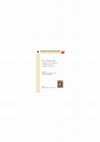
Fonti, Flussi, Onde. L'acqua tra realtà e metafora nel pensiero antico medievale e moderno, 2022
Springs and rivers, oceans and storms, ships and helmsmen, sailors, coasts and ports, shipwrecked... more Springs and rivers, oceans and storms, ships and helmsmen, sailors, coasts and ports, shipwrecked people and spectators on the shore have always the writings of philosophers, sometimes in their dimension of natural phenomena, often as phenomena, often as philosophical and religious images. The dual significance of water as reality and as a metaphor in the history of ancient, medieval and modern history of ancient, medieval and modern thought is at the centre of the studies collected in this volume, which, according to multiple perspectives and multiple perspectives and competences, examines the theme in a variety of possible implications: scientific, anthropological, metaphysical, ethical, poetic and religious, ethical, poetic and religious implications.
M. Lenzi - O.L. Lizzini - P. Totaro - L. Valente
Introduzione
D. Quarantotto, L'universo liquido: Aristotele e la fisica nell'acqua G. Zuccolin, L'umidità come principio di vita. Trasformazioni medievali di un tema classico tra medicina e filosofia. M. Nicoud, Le acque termali dei medici e dei filosofi medievali. P. Totaro, Le acque e la storia. Fossili e diluvio in Buffon.
M. Lenzi-«Sicut nauta navis». Sailorly Elements for an Archeology of Late Antique and Medieval Aristotelianism. L. Valente, Tempeste e tria genera navigantium: metafore nautiche e filosofia nella tradizione latina tardoantica e altomedievale. M. Capozzi, «Instabilis tellus, innabilis unda»: il progetto di Kant di una stabile terra della verità e di acque navigabili per la ragione.
F. Fronterotta, La metafora eraclitea del fiume e la sua interpretazione in Platone e Aristotele. R. Chiaradonna, Plotinus on Flowing Entities. O. L. Lizzini, A Flow, a Fountain of Life, a Vast Sea: Being and Its Metaphors in Arabic Philosophy.
E. Norelli, L'acqua come frontiera tra spazio divino e spazio umano in apocalissi giudaiche e cristiane antiche S. Pagani, «La perla bianca». L'acqua come sostanza e come metafora nel culto del Profeta. M. Mottolese, Hydraulic Imageries in the Kabbalistic Discourse. Metaphorics, Mythopoesis, and Ritual Context A. L. Schino, Il diluvio come metafora dell'ira divina e la critica razionalistica di Agostino Nifo e Gabriel Naudé.
S. Gentili, Il «mare dell'essere» e il naufragio di Ulisse in Dante H. Hohenegger, Metafore acquee e linguaggio in Goethe L. De Fiore, Sirene a mare, ovvero «wo aber Gefahr ist, / wächst das Rettende auch!».
Indice dei nomi.
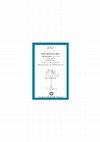
Trattato sull'Unità, 2020
Come si può dire che Dio è uno? Quando diciamo che Dio è uno, lo facciamo perché – come credono i... more Come si può dire che Dio è uno? Quando diciamo che Dio è uno, lo facciamo perché – come credono i musulmani – ne affermiamo l’unità assoluta, oppure perché – come intendono i cristiani – dell’unità divina accettiamo un’interna modulazione?
Con il Trattato sull’unità divina, il filosofo cristiano Yaḥyā ibn ʿAdī (m. 974) intende dimostrare che il vero significato dell’uno non contraddice il molteplice e che, anzi, lo implica. La concezione cristiana dell’unità divina, una “unità” che deve essere allo stesso tempo “trinità”, trova così qui le sue basi nella tradizione filosofica antica.
Il metodo del trattato è infatti filosofico, anche se puramente teologico è il suo scopo: l’indagine intorno alla nozione di uno (al-wāḥid) mira infatti a definire la quiddità (māhiyyah) di Dio. In questo senso, i diversi significati dell’uno e dell’unità che Yaḥyā presenta, sulle orme del Parmenide di Platone e seguendo in particolare la discussione aristotelica dell’uno, sono pensati in dialogo polemico con il contesto teologico islamico: l’opposizione tra la concezione cristiana dell’unità divina e l’idea islamica è nel
Trattato implicita, ma costante.
How can we say that God is one? When we say it, are we saying it because – as Muslims believe – we wish to affirm God's absolute uniqueness, or because – as Christians understand it – we recognize and accept a modulation within it? With his Treatise on Divine Unity, the Christian philosopher Yaḥyā ibn ʿAdī (d. 974) sets out to demonstrate that the true meaning of the One does not contradict that of the multiple: on the contrary, it actually implies it. The Christian concept of divine Oneness, which is also simultaneously a “Trinity”, takes its philosophical basis from this reasoning. The method of the Treatise is in reality philosophical, even if its purpose is purely theological: the consideration of the notion of the One (al-wāḥid) aims, in fact, to define the quiddity (māhiyyah) of God. In the wake of Plato’s Parmenides, and with particular attention to the Aristotelian discussion of the One, the different meanings of the One and its Oneness and Uniqueness as Yaḥyā presents them, are conceived in polemical dialogue with the Islamic theological context: the opposition between the Christian and the Islamic conceptions of divine Oneness is implicit but constant throughout the whole Treatise.
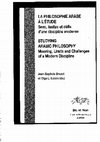
La philosophie arabe à l’étude / Studying Arabic Philosophy Sens, limites et défis d’une discipline moderne Meaning, Limits and Challenges of a Modern Discipline, 2019
Où en est l’étude de la philosophie arabe? Ce livre propose un état des lieux. Il s’agit de dress... more Où en est l’étude de la philosophie arabe? Ce livre propose un état des lieux. Il s’agit de dresser un premier bilan des travaux menés dans ce vaste champ. On examine l’historiographie, les dénominations employées; on s’interroge sur les thématiques, les objets retenus et les méthodes d’analyse mises en oeuvre; on y présente aussi des études sur des auteurs, des traditions ou des concepts, qui montrent comment le travail progresse, quelles tensions perdurent, quelles sont les perspectives.
What is the current state of the study of Arabic philosophy? This book provides an overview of the situation. The aim is to draw up a first assessment of the research carried out in the field of Arabic philosophy, reconsidering the historiography and the nomenclature, and examining the subjects and objectives, as well as the methods of analysis that have commonly been used. We also present studies – on authors, traditions and concepts – that show how work is progressing, what tensions persist, and what the prospects are.
Qu’est-ce que la prophétie? Quelle est la signification des symboles qu’elle utilise? C’est à ces... more Qu’est-ce que la prophétie? Quelle est la signification des symboles qu’elle utilise? C’est à ces questions que L’Épître sur l’établissement des prophéties répond. La prophétie y est présentée comme une nécessité. Le prophète reçoit la connaissance totale de façon immédiate et il communique au monde la révélation. Sans lui, l’échelle du savoir humain, serait imcomplète et l’humanité serait vaine, privée de droiture et de vérité. Crucial dans toute philosophie de langue arabe, le fondement même de l’Islam est ici abordé.
Angeli. Ebraismo, Cristianesimo, Islam a cura di G. Agamben e E. Coccia, 2009
Avicenna (Ibn Sīnā) by olga lucia Lizzini

Contextualizing Premodern Philosophy Explorations of the Greek, Hebrew, Arabic, and Latin Traditions , 2023
This chapter looks at Avicenna’s definition of truth or, more precisely, some aspects of it relat... more This chapter looks at Avicenna’s definition of truth or, more precisely, some aspects of it related to the theme of analysis or resolutio. Avicenna (Ibn Sīnā) tends to rework elements of the two traditions that constitute the history of analysis (and more generally the alphabet of Arabic philosophy), that is, in a very broad sense, the Aristotelian and Neoplatonic traditions. The doctrine of truth, in which logic and metaphysics are closely intertwined, clearly exemplifies this. Both senses of truth—the logical and the ontological—are based on the idea of permanence and primacy. A distinction is made between what is true or real in a proper (or absolute) sense and what is true or real in a derived (and relation-dependent) sense. As a foundation, truth is the truth of being and coincides with reality that cannot be analyzed further. At this level, being true comprehends the Necessarily Existent, the proposition expressing the existence of necessity, the principle of non-contradiction, and the quiddity or reality of the thing as such. Everything else—both at the level of truth or truthfulness and at the level of existing reality—is true because it is derived from some other thing and thus in itself is false, and is true only in virtue of its relation to some other thing.
D. Calma [dir.], Reading Proclus and the Book of Causes. III, 2022
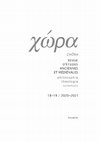
Chora, 2020
L’idée d’indépendance ou de neutralité par rapport aux modalités de l’existence qui définit la qu... more L’idée d’indépendance ou de neutralité par rapport aux modalités de l’existence qui définit la quiddité permet à Avicenne non seulement de parler d’une dualité dans l’être des choses existantes, mais aussi d’utiliser des notions – entre elles apparemment contradictoires – pour qualifier la quiddité : celle de réalité (ou vérité) –, d’un côté, et celle de possibilité (ou de fausseté), de l’autre. Cette même conception de indépendance foncière de la quiddité – qui permet de compter la quiddité comme un élément à part dans la chose existante, se reconnaît dans la solution au doute qui conclut la Maqāla fī l-tawḥīd de Yaḥyā ibn ‘Adī (mort en 974). La comparaison entre la discussion qu’Avicenne consacre dans sa Métaphysique à la quiddité et le discours de Yaḥyā ibn ‘Adī propose un contexte ultérieur pour l’étude des rapports doctrinaires entre le philosophe et théologien chrétien actif à Baghdad au Xe siècle et l’œuvre du grand philosophe persan.
Per una storia del concetto di mente, I, , 2005
Intellectus, intelligentia, mens in Avicenna», in E. Canone (a cura di), Istituto del CNR Lessi... more Intellectus, intelligentia, mens in Avicenna», in E. Canone (a cura di), Istituto del CNR Lessico Intellettuale Europeo e Storia delle Idee, L. S. Olschki, Roma - Firenze 2005, pp. 123-165
Le théologico-politique au Moyen Age, 2020
Une des questions qui intéressent la prophétie concerne son caractère métaphysique : s’agit-il d... more Une des questions qui intéressent la prophétie concerne son caractère métaphysique : s’agit-il d’un don gratuit – on dirait « une grâce » – ou est-elle plutôt de nature à suivre une loi, éthique mais aussi physique et enfin métaphysique, de sorte que le prophète doit être conçu comme un individu qui serait métaphysiquement destiné à l’être ? Cet article est consacré à la théorie de la nécessité métaphysique et politique du prophète selon Avicenne.
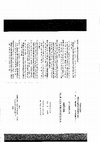
Jean-Baptiste Brenet / O. Lizzini [eds.], Avicenne? Epître sur les prophéties, [coll. Translatio], Vrin, Paris 2018, p. 7-82. , 2018
La révélation en tant que forme de langage exprime la vérité en termes non apodictiques. Cette d... more La révélation en tant que forme de langage exprime la vérité en termes non apodictiques. Cette définition, qui insiste sur la dimension linguistique du Coran, implique des éléments de tension. Et cela non seulement, comme le reconnaissaient déjà les théologiens du Kalām, à cause de l’écart qu’il faut nécessairement poser entre le langage de Dieu et celui de l’homme. La réflexion philosophique ne peut pas s’empêcher d’ajouter, aux difficultés sémantiques de la théologie, une question ultérieure : quel est le rapport entre le texte sacré et la vérité ? Le problème de la philosophie n’est donc plus seulement celui de la langue – le langage divin est supérieur, éternel et inaccessible mais il doit en même temps être soumis aux règles de la langue (il doit être compréhensible voire signifiant et analysable dans les termes de la critique sémantique) – mais aussi celui de son contenu de vérité.

The fundamental principle – ruling both Avicenna’s metaphysics and his ethics – that the action o... more The fundamental principle – ruling both Avicenna’s metaphysics and his ethics – that the action of superior causes cannot be explained in virtue of the existence of inferior effects – seems to deny any possibility of a consistent idea of providence in Avicenna’s system. Despite this fact, Avicenna recurs to the term (‘ināya; tadbīr) as well as to the idea of providence in various contexts in his oeuvre. More precisely, providence is equated to the flow of being that originates and explains the world; and this not only in respect to the fundamental, existential, positive and ‘good’ properties that belong to it – the world itself is good, the flow is the principle of good and the First Principle is the cause of the world in so far as the order of good is concerned – but also as regards the marginal, negative, non-existential and “bad” properties that can affect its individuals and that are necessarily consequents of the good itself: evil is something the First Principle “wants”, although in an accidental way, and it is therefore implicit in and contained by divine causality.
In this paper I shall outline the fundamental structure that explains the existence of individuals in the sublunary world. I do not claim to be exhaustive (some questions require further investigation); my aim is to provide an overview of the topic, with a main question in mind: on what principles does Avicenna base his idea of providence?

B. Bydén / F. Radovic (eds.), The Parva naturalia in Greek, Arabic and Latin Aristotelianism. Supplementing the Science of the Soul, Springer, Amsterdam , 2018
The general question of the relationship between representation (and symbolic representation) and... more The general question of the relationship between representation (and symbolic representation) and reality, i.e., how — and to what extent — representations stand for and correspond to reality, holds a privileged place of discussion in the Arabic-Islamic tradition: that of prophecy and of the veridical dream . In this contribution I offer some remarks on this topic, especially as regards the theory of so-called ‘imaginative’ prophecy in Avicenna (Ibn Sīnā, d. 1037). My purpose is to highlight the fact that in Avicenna’s theory of prophecy, the definition of imaginative prophecy – which is particularly problematic – involves the imaginative-combinative (or combining) power of the human soul in a specific sense: although the imaginative faculty is not properly receptive, the kind of reception imaginative prophecy involves cannot be conceived beyond the imaginative power itself and its role in elaborating symbols. In my analysis I shall be referring mainly (but not exclusively) to the Book of the Healing.
For Avicenna, happiness in the afterlife is twofold: on the one hand, it consists, as it does in ... more For Avicenna, happiness in the afterlife is twofold: on the one hand, it consists, as it does in this life, of the perception of bodily pleasure (this is also how revealed Law explains it); on the other, it is intellectual and involves the soul, in so far as the latter is separate from the body. In this respect, the pleasure of the soul – whose destiny is to become an intellectual world – is absolute. The bases of this doctrine are Avicenna’s intellectual psychology and his theory of knowledge, which in turn explains his philosophical elitism.

Totalitas. Aux origines d'un concept: Cahiers de philosophie de l’université de Caen , 53 (2016), p. 55-76, 2016
"Autour de la totalité et du non-être dans la Métaphysique d’Avicenne"
L’idée de totalité est à ... more "Autour de la totalité et du non-être dans la Métaphysique d’Avicenne"
L’idée de totalité est à repérer dans la Métaphysique d’Avicenne (Ibn Sīnā, m. 1037) par rapport à plusieurs thèmes. On pourrait tenter d’en dresser une liste, elle ne serait pas exhaustive. Les passages du Liber de philosophia prima où la correspondance entre totalitas et l’original arabe est parfaite sont les plus intéressants du point de vue métaphysique et théologique. Dans le premier, le terme est utilisé afin de montrer que la forme peut se dire aussi du tout ensemble (li-ǧamī‘ dālika). Dans le deuxième – sur lequel on s’arrête assez longuement – Avicenne présente avec le terme totalitas (al-kulliyya) son idée de création absolue ou instauration (al-ibdā‘). L’analyse de la légitimation du bien du monde, qui inclut ou est aussi un mal, offre encore une autre perspective. En général, c’est à partir des notions (ou de non-notions) de néant et d’absolu qu’Avicenne élabore l’idée du flux et donc celle de totalité qui la soutient. L'analyse de la totalité permet d’insister sur la formulation correcte pour exprimer la théorie ontologique avicennienne : d’une part, tout ce qui n’est pas le Principe doit être en soi un double et donc un composé (qui n’est pourtant pas pour cela un «tout» au sens technique); de l’autre coté, et pour ainsi dire à l’inverse, ici il faut inscrire la définition du Premier principe : le Principe est en effet incomposé et un, car il n’est rien d’autre qu’être ou existence, sans aucune limitation dépendant de l’essence.
Gli studi hanno ormai mostrato con chiarezza come Avicenna (Ibn Sīnā, 980-1037) riconsideri, tras... more Gli studi hanno ormai mostrato con chiarezza come Avicenna (Ibn Sīnā, 980-1037) riconsideri, trasformandoli, diversi aspetti del pensiero aristotelico . È su uno degli aspetti di tale elaborazione – i cui principi ispiratori si devono, almeno in parte, al neoplatonismo – che intendo soffermarmi in questo contributo, e cioè sulla questione – fondamentale in metafisica – del non essere e su quella – che le è correlata – della pensabilità del passaggio dal non essere all’essere. In particolare, si tratterà di tornare sulla discussione intorno all’origine del mondo ovvero, in termini teologici, sulla creazione



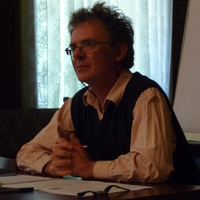







Uploads
Books by olga lucia Lizzini
M. Lenzi - O.L. Lizzini - P. Totaro - L. Valente
Introduzione
D. Quarantotto, L'universo liquido: Aristotele e la fisica nell'acqua G. Zuccolin, L'umidità come principio di vita. Trasformazioni medievali di un tema classico tra medicina e filosofia. M. Nicoud, Le acque termali dei medici e dei filosofi medievali. P. Totaro, Le acque e la storia. Fossili e diluvio in Buffon.
M. Lenzi-«Sicut nauta navis». Sailorly Elements for an Archeology of Late Antique and Medieval Aristotelianism. L. Valente, Tempeste e tria genera navigantium: metafore nautiche e filosofia nella tradizione latina tardoantica e altomedievale. M. Capozzi, «Instabilis tellus, innabilis unda»: il progetto di Kant di una stabile terra della verità e di acque navigabili per la ragione.
F. Fronterotta, La metafora eraclitea del fiume e la sua interpretazione in Platone e Aristotele. R. Chiaradonna, Plotinus on Flowing Entities. O. L. Lizzini, A Flow, a Fountain of Life, a Vast Sea: Being and Its Metaphors in Arabic Philosophy.
E. Norelli, L'acqua come frontiera tra spazio divino e spazio umano in apocalissi giudaiche e cristiane antiche S. Pagani, «La perla bianca». L'acqua come sostanza e come metafora nel culto del Profeta. M. Mottolese, Hydraulic Imageries in the Kabbalistic Discourse. Metaphorics, Mythopoesis, and Ritual Context A. L. Schino, Il diluvio come metafora dell'ira divina e la critica razionalistica di Agostino Nifo e Gabriel Naudé.
S. Gentili, Il «mare dell'essere» e il naufragio di Ulisse in Dante H. Hohenegger, Metafore acquee e linguaggio in Goethe L. De Fiore, Sirene a mare, ovvero «wo aber Gefahr ist, / wächst das Rettende auch!».
Indice dei nomi.
Con il Trattato sull’unità divina, il filosofo cristiano Yaḥyā ibn ʿAdī (m. 974) intende dimostrare che il vero significato dell’uno non contraddice il molteplice e che, anzi, lo implica. La concezione cristiana dell’unità divina, una “unità” che deve essere allo stesso tempo “trinità”, trova così qui le sue basi nella tradizione filosofica antica.
Il metodo del trattato è infatti filosofico, anche se puramente teologico è il suo scopo: l’indagine intorno alla nozione di uno (al-wāḥid) mira infatti a definire la quiddità (māhiyyah) di Dio. In questo senso, i diversi significati dell’uno e dell’unità che Yaḥyā presenta, sulle orme del Parmenide di Platone e seguendo in particolare la discussione aristotelica dell’uno, sono pensati in dialogo polemico con il contesto teologico islamico: l’opposizione tra la concezione cristiana dell’unità divina e l’idea islamica è nel
Trattato implicita, ma costante.
How can we say that God is one? When we say it, are we saying it because – as Muslims believe – we wish to affirm God's absolute uniqueness, or because – as Christians understand it – we recognize and accept a modulation within it? With his Treatise on Divine Unity, the Christian philosopher Yaḥyā ibn ʿAdī (d. 974) sets out to demonstrate that the true meaning of the One does not contradict that of the multiple: on the contrary, it actually implies it. The Christian concept of divine Oneness, which is also simultaneously a “Trinity”, takes its philosophical basis from this reasoning. The method of the Treatise is in reality philosophical, even if its purpose is purely theological: the consideration of the notion of the One (al-wāḥid) aims, in fact, to define the quiddity (māhiyyah) of God. In the wake of Plato’s Parmenides, and with particular attention to the Aristotelian discussion of the One, the different meanings of the One and its Oneness and Uniqueness as Yaḥyā presents them, are conceived in polemical dialogue with the Islamic theological context: the opposition between the Christian and the Islamic conceptions of divine Oneness is implicit but constant throughout the whole Treatise.
What is the current state of the study of Arabic philosophy? This book provides an overview of the situation. The aim is to draw up a first assessment of the research carried out in the field of Arabic philosophy, reconsidering the historiography and the nomenclature, and examining the subjects and objectives, as well as the methods of analysis that have commonly been used. We also present studies – on authors, traditions and concepts – that show how work is progressing, what tensions persist, and what the prospects are.
Avicenna (Ibn Sīnā) by olga lucia Lizzini
In this paper I shall outline the fundamental structure that explains the existence of individuals in the sublunary world. I do not claim to be exhaustive (some questions require further investigation); my aim is to provide an overview of the topic, with a main question in mind: on what principles does Avicenna base his idea of providence?
L’idée de totalité est à repérer dans la Métaphysique d’Avicenne (Ibn Sīnā, m. 1037) par rapport à plusieurs thèmes. On pourrait tenter d’en dresser une liste, elle ne serait pas exhaustive. Les passages du Liber de philosophia prima où la correspondance entre totalitas et l’original arabe est parfaite sont les plus intéressants du point de vue métaphysique et théologique. Dans le premier, le terme est utilisé afin de montrer que la forme peut se dire aussi du tout ensemble (li-ǧamī‘ dālika). Dans le deuxième – sur lequel on s’arrête assez longuement – Avicenne présente avec le terme totalitas (al-kulliyya) son idée de création absolue ou instauration (al-ibdā‘). L’analyse de la légitimation du bien du monde, qui inclut ou est aussi un mal, offre encore une autre perspective. En général, c’est à partir des notions (ou de non-notions) de néant et d’absolu qu’Avicenne élabore l’idée du flux et donc celle de totalité qui la soutient. L'analyse de la totalité permet d’insister sur la formulation correcte pour exprimer la théorie ontologique avicennienne : d’une part, tout ce qui n’est pas le Principe doit être en soi un double et donc un composé (qui n’est pourtant pas pour cela un «tout» au sens technique); de l’autre coté, et pour ainsi dire à l’inverse, ici il faut inscrire la définition du Premier principe : le Principe est en effet incomposé et un, car il n’est rien d’autre qu’être ou existence, sans aucune limitation dépendant de l’essence.
M. Lenzi - O.L. Lizzini - P. Totaro - L. Valente
Introduzione
D. Quarantotto, L'universo liquido: Aristotele e la fisica nell'acqua G. Zuccolin, L'umidità come principio di vita. Trasformazioni medievali di un tema classico tra medicina e filosofia. M. Nicoud, Le acque termali dei medici e dei filosofi medievali. P. Totaro, Le acque e la storia. Fossili e diluvio in Buffon.
M. Lenzi-«Sicut nauta navis». Sailorly Elements for an Archeology of Late Antique and Medieval Aristotelianism. L. Valente, Tempeste e tria genera navigantium: metafore nautiche e filosofia nella tradizione latina tardoantica e altomedievale. M. Capozzi, «Instabilis tellus, innabilis unda»: il progetto di Kant di una stabile terra della verità e di acque navigabili per la ragione.
F. Fronterotta, La metafora eraclitea del fiume e la sua interpretazione in Platone e Aristotele. R. Chiaradonna, Plotinus on Flowing Entities. O. L. Lizzini, A Flow, a Fountain of Life, a Vast Sea: Being and Its Metaphors in Arabic Philosophy.
E. Norelli, L'acqua come frontiera tra spazio divino e spazio umano in apocalissi giudaiche e cristiane antiche S. Pagani, «La perla bianca». L'acqua come sostanza e come metafora nel culto del Profeta. M. Mottolese, Hydraulic Imageries in the Kabbalistic Discourse. Metaphorics, Mythopoesis, and Ritual Context A. L. Schino, Il diluvio come metafora dell'ira divina e la critica razionalistica di Agostino Nifo e Gabriel Naudé.
S. Gentili, Il «mare dell'essere» e il naufragio di Ulisse in Dante H. Hohenegger, Metafore acquee e linguaggio in Goethe L. De Fiore, Sirene a mare, ovvero «wo aber Gefahr ist, / wächst das Rettende auch!».
Indice dei nomi.
Con il Trattato sull’unità divina, il filosofo cristiano Yaḥyā ibn ʿAdī (m. 974) intende dimostrare che il vero significato dell’uno non contraddice il molteplice e che, anzi, lo implica. La concezione cristiana dell’unità divina, una “unità” che deve essere allo stesso tempo “trinità”, trova così qui le sue basi nella tradizione filosofica antica.
Il metodo del trattato è infatti filosofico, anche se puramente teologico è il suo scopo: l’indagine intorno alla nozione di uno (al-wāḥid) mira infatti a definire la quiddità (māhiyyah) di Dio. In questo senso, i diversi significati dell’uno e dell’unità che Yaḥyā presenta, sulle orme del Parmenide di Platone e seguendo in particolare la discussione aristotelica dell’uno, sono pensati in dialogo polemico con il contesto teologico islamico: l’opposizione tra la concezione cristiana dell’unità divina e l’idea islamica è nel
Trattato implicita, ma costante.
How can we say that God is one? When we say it, are we saying it because – as Muslims believe – we wish to affirm God's absolute uniqueness, or because – as Christians understand it – we recognize and accept a modulation within it? With his Treatise on Divine Unity, the Christian philosopher Yaḥyā ibn ʿAdī (d. 974) sets out to demonstrate that the true meaning of the One does not contradict that of the multiple: on the contrary, it actually implies it. The Christian concept of divine Oneness, which is also simultaneously a “Trinity”, takes its philosophical basis from this reasoning. The method of the Treatise is in reality philosophical, even if its purpose is purely theological: the consideration of the notion of the One (al-wāḥid) aims, in fact, to define the quiddity (māhiyyah) of God. In the wake of Plato’s Parmenides, and with particular attention to the Aristotelian discussion of the One, the different meanings of the One and its Oneness and Uniqueness as Yaḥyā presents them, are conceived in polemical dialogue with the Islamic theological context: the opposition between the Christian and the Islamic conceptions of divine Oneness is implicit but constant throughout the whole Treatise.
What is the current state of the study of Arabic philosophy? This book provides an overview of the situation. The aim is to draw up a first assessment of the research carried out in the field of Arabic philosophy, reconsidering the historiography and the nomenclature, and examining the subjects and objectives, as well as the methods of analysis that have commonly been used. We also present studies – on authors, traditions and concepts – that show how work is progressing, what tensions persist, and what the prospects are.
In this paper I shall outline the fundamental structure that explains the existence of individuals in the sublunary world. I do not claim to be exhaustive (some questions require further investigation); my aim is to provide an overview of the topic, with a main question in mind: on what principles does Avicenna base his idea of providence?
L’idée de totalité est à repérer dans la Métaphysique d’Avicenne (Ibn Sīnā, m. 1037) par rapport à plusieurs thèmes. On pourrait tenter d’en dresser une liste, elle ne serait pas exhaustive. Les passages du Liber de philosophia prima où la correspondance entre totalitas et l’original arabe est parfaite sont les plus intéressants du point de vue métaphysique et théologique. Dans le premier, le terme est utilisé afin de montrer que la forme peut se dire aussi du tout ensemble (li-ǧamī‘ dālika). Dans le deuxième – sur lequel on s’arrête assez longuement – Avicenne présente avec le terme totalitas (al-kulliyya) son idée de création absolue ou instauration (al-ibdā‘). L’analyse de la légitimation du bien du monde, qui inclut ou est aussi un mal, offre encore une autre perspective. En général, c’est à partir des notions (ou de non-notions) de néant et d’absolu qu’Avicenne élabore l’idée du flux et donc celle de totalité qui la soutient. L'analyse de la totalité permet d’insister sur la formulation correcte pour exprimer la théorie ontologique avicennienne : d’une part, tout ce qui n’est pas le Principe doit être en soi un double et donc un composé (qui n’est pourtant pas pour cela un «tout» au sens technique); de l’autre coté, et pour ainsi dire à l’inverse, ici il faut inscrire la définition du Premier principe : le Principe est en effet incomposé et un, car il n’est rien d’autre qu’être ou existence, sans aucune limitation dépendant de l’essence.
For Avicenna (Ibn Sīnā) metaphysics is a science (ʿilm), i.e., a perfectly rationally established discipline that allows human reason to achieve an authentic understanding of the inner structure of the world. Metaphysics is the science of being qua being and therefore the science that explains every being. In his interpretation, Avicenna fuses the Aristotelian tradition, which he intends to renew (Gutas 2014), with the Neo-Platonic idea of emanation, on which he builds his system: metaphysics thus includes theology, cosmology and angelology, and provides a foundation for physics, psychology, prophetology and eschatology. Indeed, metaphysics even demonstrates “the principles of the particular sciences” that investigate “the states of particular existent things” (Ilāhiyyāt, I, 2, 14, 18–15, 7) and are subordinate to it (Bertolacci 2006: Ch. 7). So metaphysics is “first” and “at the head” of all sciences (Ilāhiyyāt, I, 3, 18, 14–17; Houser 1999; Lizzini 2005) and is universal not only because it concerns being qua being (instead of just some aspects of it), but also because it comprehends reality—and the system of knowledge this implies—as a whole (instead of just some portions of it).
In this article, which has reference mainly, but not exclusively, to the Ilāhiyyāt of Kitāb al-Šifā' (known in English as the Metaphysics of the Book of the Healing or of the Book of the Cure), I shall start—after introducing Avicenna's sources—with a brief discussion of the status of metaphysics as a science, and then illustrate Avicenna's analysis of existence and the theology that arises from it. Thereafter I shall focus on Avicenna's theory of emanation, highlighting its essential aspects.
intellect théorique et intellect pratique, qui est à la base de la distinction
des deux genres de vie, mais il l’implante sur un terrain néoplatonicien
et en amplifie le domaine pour y comprendre le monde
céleste dans les deux modes qui l’expliquent : l’eschatologie et
l’angélologie. L’horizon aristotélicien se trouve ainsi transformé et
même altéré chez Avicenne : la distinction des deux intellects sert à
Avicenne, comme à Aristote, pour fournir une articulation de la vie
psychique de l’homme; elle est – et cela encore comme chez Aristote
– hiérarchisée, la vie pratique se trouvant rangée au-dessous de la
vie théorétique; mais, et on remarque ici une différence par rapport
au Stagirite, elle trouve son sens ultime dans l’horizon eschatologique
et encore plus profondément dans la théorie émanative et
métaphysique qui le soutient.
métaphysique (en arabe Kitāb al-Ilāhiyyāt ; Liber de philosophia prima, dans la traduction latine). Les Latins furent donc initiés à la métaphysique et à la psychologie aristotéliciennes, sinon seulement, sans doute
aussi, à travers l’interprétation avicennienne. C’est en ce sens que les textes d’Avicenne contribuèrent à la naissance d’une nouvelle façon de faire de la philosophie (Nardi 1912 ; Gilson 1929-30 ; de Libera 1990/2012 ; Porro 2006 ; Jolivet 2009/2013). Nous nous proposons ici de relire quelques éléments de cette histoire de translatio, de lecture, d’interprétation et de philosophie. Cela nous permettra d’examiner quelques aspects importants de la toute première réception – au XIIe siècle – des textes d’Avicenne et de reconsidérer les distinctions que l’historiographie a tenté d’établir pour la comprendre : l’avicennisme latin, dont parla de Vaux, l’idée gilsonienne d’augustinisme avicennisant, que de Vaux voulait nuancer sinon corriger.
mais aussi à sa célébration telle qu’on la retrouve dans quelques textes du XVIIIe siècle. Avec les progrès du travail d’exhumation et d’édition des textes réalisés par les orientalistes, les oeuvres qui ne furent pas traduites en latin au moyen âge acquièrent de l’importance.
Avicenne est alors soit un transmetteur, un
aristotélicien, soit un mystique. Avicenne est ainsi une figure double. Partisans de l’idée qui veut que la philosophie soit ‘autre’ en terre d’Islam par rapport à ce qu’elle est en Occident, les orientalistes insistent sur l’irrationalité (ou le manque d’originalité) d’Avicenne. Pour les historiens de la philosophie du XIXe siècle, Avicenne est par contre essentiellement un précurseur, à savoir source des erreurs des scolastiques. Ainsi la médiation du savoir grec à l’Occident devient-elle la source de déviations, d’erreurs par rapport à la vérité et à la
rationalité chrétiennes. Au début du XXe siècle, l’invention des catégories d’‘augustinisme avicennisant’, d’‘avicennismo agostinistico’ ou encore d’‘avicennisme’, s’inscrit dans un mouvement qui reprend l’idée des ‘erreurs’ d’Avicenne pour la nuancer, la corriger, et parvenir enfin à lui substituer le concept d’influence.
affirmation of [divine] unity (al-Maqāla fī l-tawḥīd) plays in the Arabic-Islamic philosophical and theological tradition6. The Treatise – as the title, which is of paramount importance, already suggests – refers to the fundamental concept of Islamic monotheism, on the one hand, and to the philosophical effort to find a logically coherent predication of the First Principle, on the other. It is on the basis of this premise that this contribution offers a general introduction to the Treatise and to explain its inner structure (summarized in a schematic way in the appendix).
For Avicenna, establishing the existence of the First Principle, its unity, reality and magnificence is the main task of metaphysics. Indeed, the question of the unity and oneness of God - the tawhīd - has occupied the falāsifa - readers and continuators of the ancient Greek philosophers in the Islamic context - since the earliest times. While offering an introduction to this major theme, the article examines in particular some passages from al-Fārābī's Book of the One and Unity, a text in which the "second master" proposes a precise conception of what is one in-itself ; a conception which, based on the idea of identity, or quiddity of the thing, seems to have played a decisive role not only in the philosophical elaboration of the unity of God, but also in the conception of the distinction between essence and existence, which is at the centre of Avicennian metaphysics
Of the various applications of the concept of nothingness or non-existence, the one that concerns the origin of the world is considered here, attempting to follow the path that, also starting from the Qur'ān, has led to the theological and philosophical conception of creatio ex nihilo, that is, to that elaboration of the divine creative act whose definition implies the idea of nothingness or non-existence. An attempt is thus made to understand to what extent and in what way the idea of nothingness intervenes in the definition of God's creative act in the Kalām first and then in the falsafa. In addition to the theme of creation itself, the discussion, which originated in the Mu'tazilite sphere (and then resumed in the Aš'arite sphere) around the meaning of the term 'non-existent' (ma'dūm) is addressed. The background of the analysis is the conviction that the ideas of creation, non-existence and emanation are valid as different articulations of the same great exegetical process: the Qur'ān's position on creation, which Wolfson described as "vague", has ended up, in fact, if not justifying, at least enabling the philosophers' answer to the question of the creation of the world: that is, on the one hand, it entailed the urgency of a theological elaboration of the divine creative act, on the other, it allowed the philosophical, emanative interpretation to claim for itself at least the value of a possible interpretation.
body. The soul is determined by the very emanative process that explains reality. In that sense, the soul’s distinction cannot be horizontal (as if the soul could be divided into different parts, such as the physical ones—vegetable and animal—and the metaphysical ones—the rational souls of man and of celestial intelligences), but must be vertical. Soul as a substance has no real connection with either side (material or spiritual) of the world. Its connection with the physical reality is only operational. If a physical point of view exists (and psychology is to be considered a part of physics), a metaphysical point of view exists more truly: the principle of nature comes from above and physics is no more than a part of metaphysics.
In Ishrāq 2019, pp. 132-150 (English revised and updated version of «L’âme chez Avicenne : quelques remarques autour de son statut épistémologique et de son fondement métaphysique», Documenti e Studi sulla Tradizione Filosofica Medievale 21 (2010), pp. 223-242).
Os tradutores agradecem a revisão de Rosalie H. de
Souza Pereira
"Homology argument" analyzed by Olga Lizzini on Ibn Sina's Kitab al-Shifa, Ilahiyat II.4
Active participation by the students is required.
The aim of the course is to teach the students how to read a philosophical text and therefore how to formulate their own questions in reading it. In other words, students who complete the course should have developed the skills required for a ‘Tekstcollege’, i.e. textual analysis.
More precisely, students who complete the course should have acquired a fundamental knowledge of the philosophical themes discussed in Aristotle’s text (the definition of the soul and of its faculties; the different kinds of souls; the meaning of intellection), but also a general understanding of the main conceptual issues related to Aristotle’s De anima (e.g. the Aristotelian doctrine of potency and act; the problem of the separate intellect).
Students who complete the course should also have acquired the skills of reflecting on philosophical texts (in translation), formulating their own questions on them and analysing philosophical arguments.
A general knowledge of the history of ancient philosophy (Pre-Socratic Philosophy, Plato, Aristotle and Neo-Platonism in particular) is certainly an advantage for those who are about to read this important text.
Amphidialogos is a box, a drawer, a room, a shelf, and a cabinet; in short, a container in which, bit by bit, we’ll place information about events, activities, courses, conferences, seminars, publications, websites and anything else related to the history of ancient and medieval thought, its origins and its interplay with the ambient culture. We’ll then preserve all the bits, while making them visible.
The languages accommodated in this box of amphidialogos – which is a dialogue between different subjects, but also about different objects – are Greek, Arabic and Latin, and – as opportunity and luck will have it – Syriac, Persian, Hebrew, Armenian and so on
Amphidialogos is "organized" (if an occasionally disorderly drawer or a showcase that often exhibits things made by other people can be said to be organized), by Olga Lizzini and Marije Martijn with the support of Benno van Croesdijk and Wouter Goris.
Any event, activity, publication etc. that you make known to us and that may be in keeping with our intentions and our curiosity is welcome. There are no language restrictions: amphidialogos is indeed in English, ma anche in Italiano, en Français, auf Deutsch, in het Nederlands, and, if possible, στην ελληνική γλώσσα wa-bi-l-lugha al-‘arabiyya.
Put amphidialogos in your own drawer and if you like it, let other people know about it.
With our best wishes and in the hope of being in touch soon,
Olga Lizzini - Marije Martijn
Journée d'études du projet « L’Un divin et ses multiples : des modèles du tawḥīd entre philosophie, chiisme et soufisme », projet "Pour une islamologie d’excellence" de l'Institut français d’islamologie (IFI). Organisée parOlga Lucia Lizzini (Aix-Marseille Université/Iremam) et Mathieu Terrier (CNRS, LEM, IISMM).
Premier article de la profession de foi, l’unicité de Dieu (tawḥīd) est au centre des courants doctrinaux et spéculatifs de l’islam ; elle est aussi la marque de ceux réputés les plus hétérodoxes : chiisme ismaélien ou duodécimain, falsafa, soufisme de l’école d’Ibn ‘Arabī. Dans le but d'une étude conjointe des modèles d’unicité divine (tawḥīd) élaborés dans la falsafa, la mystique et le chiisme (10ème- 17ème siècles), nous proposons une première journée d’études à l'université d'Aix-Marseille. Des spécialistes et de jeunes chercheurs travaillant sur différents courants de la tradition intellectuelle de l’islam classique sont invités à présenter les textes philosophiques et/ou théologiques discutant les différents modèles de l’Un divin (l’émanatisme, l’apophatisme et le monisme ontologique). L'objectif du projet, qui comprendra plusieurs journées d'études, est d'esquisser une vue d’ensemble des conceptions du tawḥīd, dans leurs sources et leurs évolutions conjointes, et d’éclairer les relations historiques et doctrinales entre différentes visions de l’Absolu.
Olga L. Lizzini – Mathieu Terrier – Cecilia Martini – Jawdath Jabbour – Maxime Delpierre – Gregory Vandamme – Fârès Gillon - Daniel De Smet
The corpus of smaller treatises, tales, and letters on various topics attributed to Avicenna poses particular challenges both in terms of philosophical and philological analysis. In 2014, Dimitri Gutas (Avicenna and the Aristotelian Tradition, 2nd ed.) provided a revised list of works that included, alongside the well-known summae, also the lesser-known shorter writings. While the authenticity of some of these rasāʾil remains questionable, it is clear that they all shaped in different degrees the perception on Avicenna throughout the centuries and, thus, deserve more attention from scholars to bring to light their variegated history of transmission and reception as well as their value for understanding Avicenna.
Many of these smaller texts remain unedited and discuss topics that are rarely studied or ap- pear otherwise difficult to integrate into the systematic framework of Avicenna’s philosophy. They may enrich or surely substantiate our own view of Avicenna, while inauthentic treatises could provide important insight into Avicennian circles and later forgeries may have been sources of misconceptions and erroneous or otherwise peculiar readings among interpreters in history.
Against this background, the fourth meeting of the Avicenna Study Group aspires to set a new standard in dealing with the important corpus of Avicenna’s “minor” works and welcomes rigorous and innovative contributions that could feature, for example:
• editions,
• translations,
• manuscript studies,
• historical reconstructions,
• philosophical analyses,
• new hitherto unknown or unlisted treatises,
• comparisons with other “minor” works as well as
• comparisons with the “major” works.
Qu’est-ce que cela signifie de choisir de ne pas philosopher plutôt que de philosopher ? Pour Éric Chaumont
2-3 décembre 2021, MMSH, salle Georges Duby, Aix-en-Provence et en visioconférence. Organisées par Olga L. Lizzini, professeure des universités AMU/IREMAM et Nadjet Zouggar, maître de conférences AMU/IREMAM.
PROGRAMME
Jeudi 2 décembre 2021, 9h-17h, MMSH, salle Georges Duby
Lien Zoom / ID de réunion : 920 4978 1859 / Code secret : 016832
9h – Accueil et introduction : Olga Lucia Lizzini (AMU/IREMAM) et Nadjet Zouggar (AMU/IREMAM)
9h30-11h
Jean-Baptiste Brenet (Université Panthéon – Sorbonne, Paris) : « Anti-intellectualisme ou supra-intellectualisme ? Une lecture du Hayy ibn Yaqzān de Ibn Tufayl »
Ahmed Oulddali (Université de Lyon/IREMAM) : « Les réfutations de Fakhr al-Dīn al-Rāzī »
11h-11h20 – Pause café
11h20-12h50
Samuela Pagani (Università del Salento, Lecce) : « L’opposition entre l’imagination et l’abstraction : quelques textes soufis » (via Zoom)
Gregory Vandamme (UCL, Louvain-la-Neuve) : « La perplexité (ḥayra) comme voie de connaissance dans le soufisme classique : de Sarrāj à Ibn ʿArabī »
12h50 – 14h30 : déjeuner à la MMSH
14h30-17h
Francesco Chiabotti (INALCO, Paris) : « Pourquoi une sur-rationalité s’allie-t-elle à une rationalité traditionaliste ? Sur le rôle de le théologie dans le soufisme d’Abd al-Karīm al-Qushayrī »
Ziad Bou Akl (ENS, Paris) : « La fonction critique du kalām ash‘arite dans la pensée d'al-Ghazālī »
Olga L. Lizzini (AMU/IREMAM) : « Qu’est-ce que l’anti-intellectualisme pour les falāsifa ? »
19h30 – Dîner
Vendredi 3 décembre 2021, 9h-13h, MMSH, salle Georges Duby
Lien Zoom / ID de réunion : 942 1515 8382 / Code secret : 104002
Adrien Candiard (IDEO, Le Caire) : « La vérité sans système. La pensée de l’immédiateté dans le Darʾ taʿāruḍ al-ʿaql wa-l-naql d’Ibn Taymiyya »
Nadjet Zouggar (AMU/IREMAM) : « Les bons et les mauvais philosophes dans le discours hérésiologique d’Ibn Qayyim al-Jawziyya »
11h-11h20 – Pause café
11h20 – 13h
Youssuf T. Sangaré (Université Clermont Auvergne, Clermont-Ferrand) : « ‘Abd al-Muta‘āl al-Ṣa‘īdī (1894-1971) : entre dénonciation de la classe des ‘ulamā’ et l’appel à la restauration de l’ijtihād »
Olga L. Lizzini (AMU/IREMAM) et Nadjet Zouggar (AMU/IREMAM) – Conclusion des travaux
By attempting to answer some fundamental questions - What kinds of themes and issues have been analysed and why? Why have some authors received more attention than others? What is the meaning of such locutions as "Arabic, Islamic, Islamicate philosophy" and "Philosophy of (Medieval) Islam"? - the colloquium should lead to a more precise definition of this relatively new discipline, the history of Arabic (or Islamic) philosophy, and should also allow us to indicate and discuss the historiographic trends revealed by the most representative scholars of the discipline.
"
Johan van Benthem (Logic)
Sarah Broadie (History of Philosophy)
John Broome (Ethics and Practical Philosophy)
Katherine Hawley (Theoretical Philosophy)
The conference dates are December 11 and 12, 2015. The conference is hosted by the Vrije Universiteit Amsterdam. More information will follow later this year.
D. Quarantotto, L'universo liquido: Aristotele e la fisica nell'acqua-G. Zuccolin, L'umidità come principio di vita. Trasformazioni medievali di un tema classico tra medicina e filosofia-M. Nicoud, Le acque termali dei medici e dei filosofi medievali-P. Totaro, Le acque e la storia. Fossili e diluvio in Buffon. METAFORE DELLA NAVIGAZIONE. M. Lenzi-«Sicut nauta navis». Sailorly Elements for an Archeology of Late Antique and Medieval Aristotelianism-L. Valente, Tempeste e tria genera navigantium: metafore nautiche e filosofia nella tradizione latina tardoantica e altomedievale-M. Capozzi, «Instabilis tellus, innabilis unda»: il progetto di Kant di una stabile terra della verità e di acque navigabili per la ragione. F. Fronterotta, La metafora eraclitea del fiume e la sua interpretazione in Platone e Aristotele-R. Chiaradonna, Plotinus on Flowing Entities-O. L. Lizzini, A Flow, a Fountain of Life, a Vast Sea: Being and Its Metaphors in Arabic Philosophy. E. Norelli, L'acqua come frontiera tra spazio divino e spazio umano in apocalissi giudaiche e cristiane antiche-S. Pagani, «La perla bianca». L'acqua come sostanza e come metafora nel culto del Profeta-M. Mottolese, Hydraulic Imageries in the Kabbalistic Discourse. Metaphorics, Mythopoesis, and Ritual Context-A. L. Schino, Il diluvio come metafora dell'ira divina e la critica razionalistica di Agostino Nifo e Gabriel Naudé. S. Gentili, Il «mare dell'essere» e il naufragio di Ulisse in Dante-H. Hohenegger, Metafore acquee e linguaggio in Goethe-L. De Fiore, Sirene a mare, ovvero «wo aber Gefahr ist, / wächst das Rettende auch!». Indice dei nomi.
Olga L. Lizzini
The Catholic University of America Press
Volume 88, Number 1, January 2024
pp. 138-144
doi:10.1086/684373